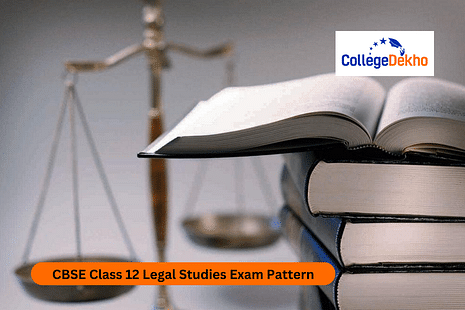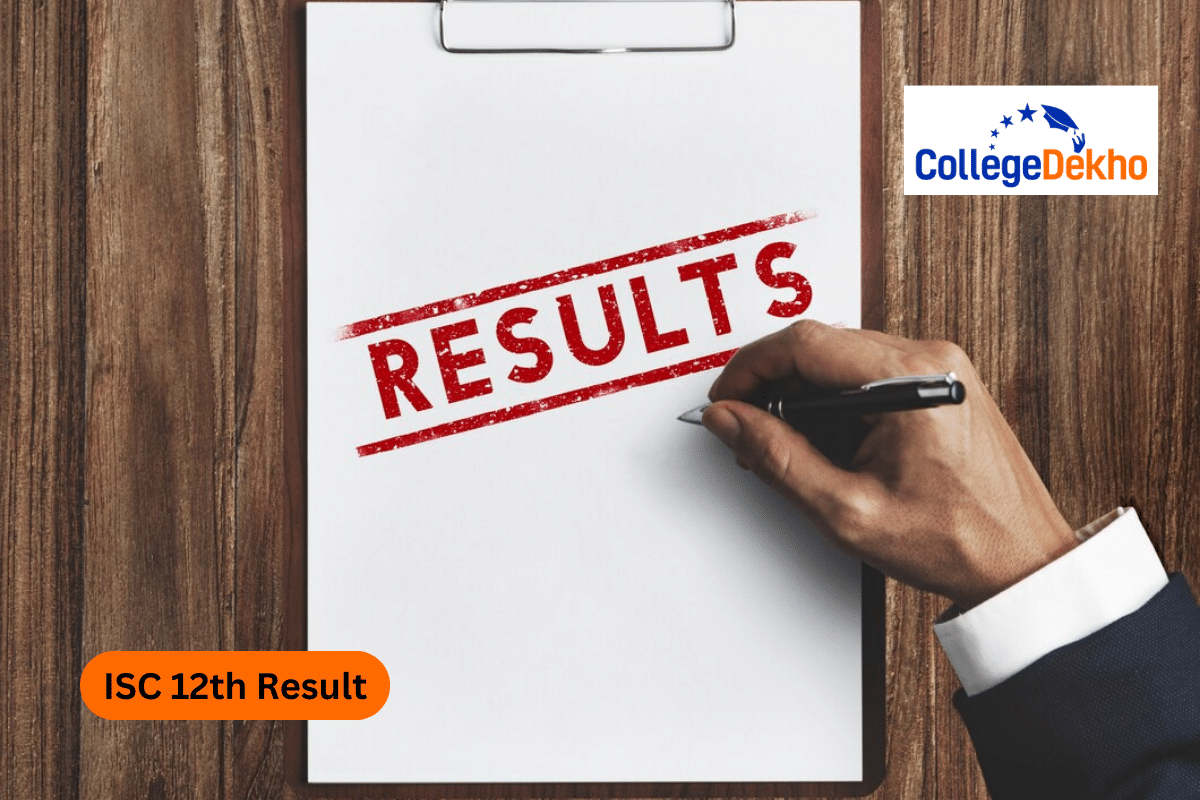

Never Miss an Exam Update
CBSE Class 12 Legal Studies Exam Pattern 2026 provides information about the marking scheme, weightage of sections or topics, type of questions, and more. The board examination is conducted for 100 marks (theory 80 + internal/practical/ongoing assessment 20) and the duration of the paper is 3 hours. Competency-based questions form a significant portion, including MCQs, case-based and source-based items (roughly 20 % MCQs and 30 % case/source based) while the rest are short-answer and long-answer questions. Students must secure at least 33 % in each component to pass. The syllabus covers eight units including Judiciary, ADR, Business & General Laws, Human Rights, Legal Profession, and International Law, with specific weightage assigned to each unit. The duration of the paper will be three hours. A total of 8 units are included in the curriculum according to the
CBSE Class 12 Legal Studies Syllabus 2026
. Students must complete the syllabus in due time to revise using the sample papers. They can use
CBSE Class 12 Legal Studies Sample Paper 2026
to prepare for the board exams.
The CBSE Class 12 Legal Studies Previous Year Question Papers are also an excellent resource for familiarizing yourself with the syllabus and exam pattern. CBSE 12th Board 2026 exam will begin on February 15, 2026. The comprehensive
CBSE Class 12 Date Sheet 2026
is still awaited and will be published on the official website in December. Meanwhile, students are advised to go through the detailed CBSE Class 12 Legal Studies Blueprint 2026 below.
CBSE Class 12 Legal Studies Exam Pattern 2026
The total CBSE marking scheme 2026 class 12 for Legal Studies is 100. The detailed topic-wise marks distribution is tabulated below for the student's reference"
Unit Number | Units | Marks |
|---|---|---|
Unit 1 | Judiciary | 08 |
Unit 2 | Alternative Dispute Resolution in India (ADR) | 08 |
Unit 3 | Topics in Law- I (Business Laws) Chapter 3 (A) - Law of Contract Chapter 3 (B) - Law of Torts Chapter 3 (C) - Law of Property Chapter 3 (D) - Intellectual Property Law | 20 |
Unit 4 | Topics in Law- II (General Laws) Chapter 4 (A) -Law and Sustainable Development Chapter 4 (B)- Forms of Legal Entities Chapter 4 (C) - Criminal Laws in India | 10 |
Unit 5 | Concept of Human Rights Chapter 5 (A)-Human Rights in India Chapter 5 (B)-Human Rights ViolationsComplaint Mechanism (Quasi-Judicial Bodies) | 10 |
Unit 6 | International Law | 08 |
Unit 7 | Legal Profession in India | 08 |
Unit 8 | Legal Services | 08 |
- | Project | 20 |
Total | - | 100 |
For better preparation, students must also check out the CBSE Class 12 Legal Studies Important Questions 2026 .
CBSE Class 12 Legal Studies Question Paper Pattern 2026
Students can refer to the detailed information about the question paper pattern of the CBSE Class 12 Legal Studies Paper from the table given below:
Sections | Type of Questions | No. of Questions | Marks |
|---|---|---|---|
A | MCQs | 20 Compulsory questions | 20*1=20 |
B | Very Short answer type questions | 8 questions to be answered | 8*2= 16 |
C | Short answer type questions | 8 questions to be answered | 8*3= 24 |
D | Long answer type questions | 4 questions to be answered | 4*5=20 |
CBSE Class 12 Legal Studies Question Paper Design 2026
The table below consists of the question paper design of the syllabus of Legal Studies Class 12 CBSE 2026
| S No | Competencies |
Total
Marks | % Weightage |
|---|---|---|---|
| 1 |
Remembering and Understanding:
Demonstrate your remember of previously taught content by bringing up terms, answers, facts, and fundamental ideas. Show that you grasp the information by classifying, contrasting, translating, interpreting, providing descriptions, and summarizing the key points. | 24 | 30 |
| 2 |
Applying:
Apply newly acquired knowledge, facts, techniques, and principles to solve issues in novel contexts. | 24 | 30 |
| 3 |
Analysing, Evaluating and Creating:
Analyze and dissect data by determining reasons or motivations. Conclude and gather data to back up generalizations. Present and defend perspectives by using a set of criteria to evaluate facts, the viability of ideas, and the caliber of the work. Put information together differently by putting components together novelly or suggesting alternate approaches. | 32 | 40 |
| Total | 80 | 100 |
CBSE Class 12 Legal Studies 2026 Rubrics
| Topic | Exceeding (76-100 percent) | Accomplished (61-75 percent) | Developing (34-60 percent) | Beginning 13(15-33 percent) |
|---|---|---|---|---|
| Presentation of all facts of the case |
● All the relevant facts are presented clearly in a chronological, organized, logical and interesting sequence
● The facts are supported with relevant evidence related to the case | ● Most of the crucial facts have been stated sequentially as per the happening of the case | ● Some facts are stated but not in a sequential manner | ● Only a few unrelated and irrelevant facts have been stated |
| Statement of Legal problem and prediction about outcome |
● Legal problem has been precisely defined and unambiguously stated
● Analysis of the legal problem has been done thoroughly and predicts clear outcome with log |
● Legal problem has been nearly correctly stated
● Analysis of the legal problem predicts a near clear outcome |
● Legal problem has been vaguely conceived
● Analysis of the Legal problem does not predict a clear outcome |
● Legal problem has not been identified clearly,
● No analysis of the legal problem has been done to predict the outcome |
| Information gathering | ● The information gathered in relation to the case is relevant and sufficient to encompass all crucial facts and all applicable laws | ● The information gathered in relation to the case is relevant and sufficient to encompass only crucial facts without applicable laws | ● The information gathered in relation to the case is relevant but insufficient to encompass all relevant facts and applicable laws | ● The information gathered in relation to the case is insufficient |
| legal analysis and reasoning | ● Legal analysis is done by organizing evidence to accentuate differences, or similaritiesrelated to case. Use superior inductive and deductive reasoning abilities and present analogy. | ● Legal analysisis done by organizing some evidence but organization is less than effective. Shows less Logical reasoning (inductive deductive) than required. | ● Legal analysisis done by organizing some evidences but organization is not effective. Logical reasoning (inductive – deductive) is missing. | ● List some evidences but not able to organize it. Legal analysis is incoherent |
| Identification of decidendi and obiter dicta | ● Ratio decidendi and Obiter dicta has been identified in a crystal clear terms | ● Ratio decidendi and Obiter dicta has been little less clearly identified | ● Ratio decidendi and Obiter dicta has been vaguely identified | ● Ratio decidendi and Obiter dicta has not been identified |
| Reflections on the Case | ● Corroborate alternative arguments with research and innovation. Question existing beliefs. Show inconsistencies in existing body of evidence to arrive at result. Analyse pros and cons of existing decision viz a viz alternative solutions. | ● Identify connection between existing laws and their application in this case. Consider alternative arguments to affect the present outcome. | ● Analyse from a personal perspective why a particular action/decision has happened. | ● repeats only what has happened in the case |
Students can regularly visit the page for detailed information about the CBSE Class 12 Legal Studies exam pattern. Students can also check the
CBSE Class 12 Result
here.
Are you feeling lost and unsure about what career path to take after completing 12th standard?
Say goodbye to confusion and hello to a bright future!

Was this article helpful?



























